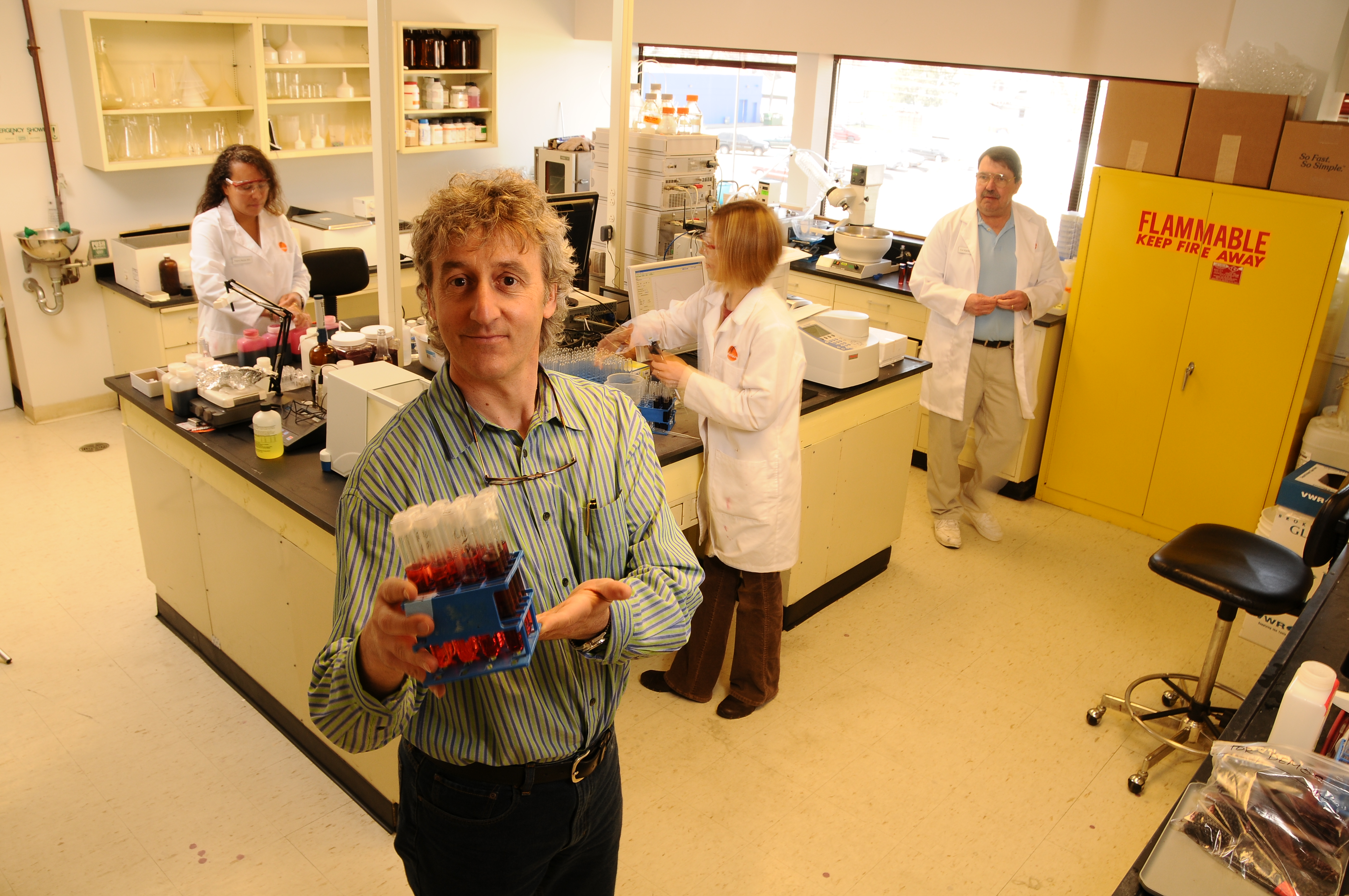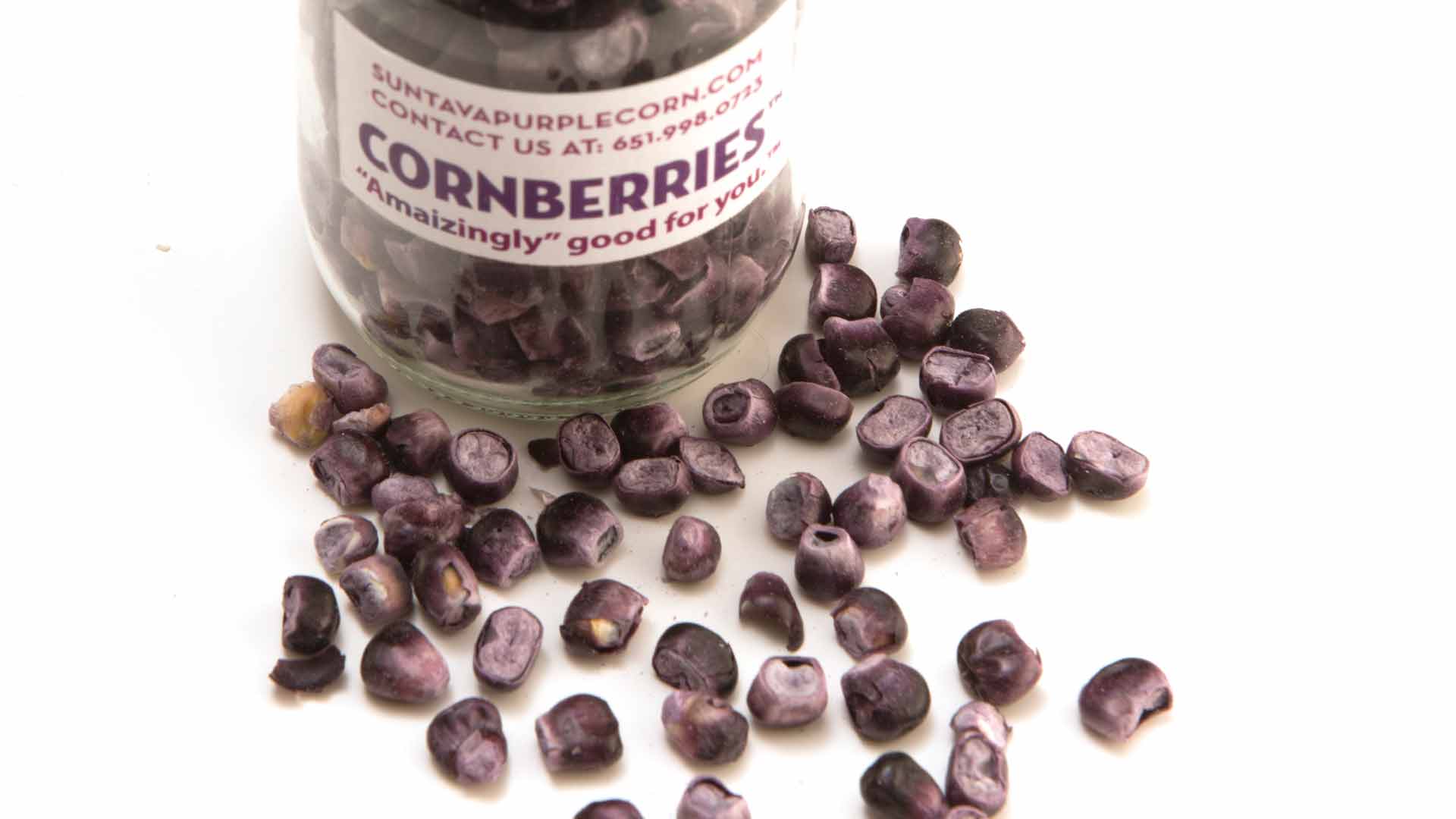 > Listen to a radio segment about Suntava
> Listen to a radio segment about Suntava
Bill Petrich says he didn’t know for sure how expansive the business could be when he became CEO of Suntava in 2007. Petrich was hired to build a fledgling business marketing products from a variety of purple corn the company’s founders had developed.
Initial efforts focused on a natural red colorant extracted from the corn. But the business has become so much more than just a pretty color.
“This has gone in more directions than I could have ever imagined,” Petrich admits.
Suntava still supports the Sayela™ colorants as a natural alternative to the petroleum based Red Dye 40 for the food and beverage industry, but it wasn’t long into the company’s existence that Petrich began paying greater attention to possible uses for the grain. Even though their proprietary process extracts purple color from the corn grain, there was plenty of vivid purple still in the meal. But color wasn’t the only thing left in the corn.
A healthy option
Suntava colorants and whole grains are rich in anthocyanins, a powerful antioxidant. In fact, ounce for ounce, Suntava Purple Corn has double the antioxidant level of blueberries. The health benefits, combined with the unique color and versatility of the grain have opened numerous exciting opportunities for cereals, sweet and salty snack foods, craft brewing and even spirits.
Suntava Purple Corn is already used to make corn chips, tortillas, masa flour and more. In recent months, new partnerships have been formed, taking Suntava’s unique purple ingredients to new markets.
In January, Cascadian Farm launched a Berry Vanilla Puffs cereal nationally. Cascadian Farm is a General Mills company that produces organic and non-GMO snack and cereal products. The purple berries in the cereal are made from Suntava Purple Corn because no artificial coloring is needed.
Suntava has formed a partnership with Stiebs and Smith Frozen Foods, two west coast companies who will produce and market individually quick frozen (IQF) kernels, freeze dried kernels, powder and purees. Stiebs is a California-based supplier of juices, concentrates, purees and nutraceuticals. This partnership opens the door for Suntava ingredients to be used in foods like salsa, frozen vegetable mixes, healthy snacks, purees and soup.
Briess Malt and Ingredients Company of Wisconsin is working with Suntava to produce, market and distribute purple corn nectar. Briess is North America’s leading producer of specialty malts and value added ingredients for the brewing, distilling, food and pet food industries. This partnership opens yet another door into the craft brew industry, health bar and natural sweetener markets.
For companies striving to market healthy, natural products with flair, Suntava ingredients are a perfect fit.
“In general, we’ve had a warm reception,” Petrich says. “It’s taken time to get there, but companies are beginning to realize the benefits.”
A story to tell
Petrich says companies like both Suntava Purple Corn’s color and nutritional benefits. Test results have shown that snacks, cereals, crackers and baked goods made with their corn provide from 18-35 milligrams of anthocyanins per one ounce serving, whereas studies have shown that the average American consumer gets about 12.5 milligrams per day.
Beyond the nutrition and the color, many companies and consumers are attracted to Suntava’s story. The purple corn is a non-GMO variety, developed by Lee and Joann French of Lamberton, Minnesota. After years of traditional breeding using strains derived from ancient red maize, the Frenches developed the corn that is distinctively purple from root to tassel. The variety is now grown on thousands of acres in southwestern Minnesota as well as other parts of the country.
“The footprint of where we are growing the corn continues to expand,” Petrich says. “The corn is a very scalable and mobile product that can be grown in multiple regions.”
“We’ve got complete control of the seed from the breeding practices all the way up to the production, so our customers can be assured of a high quality, consistent product each and every time they receive product from Suntava,” says Joel Bodin, Suntava vice president of business development.
The Frenches began working with AURI back in 2002, looking for help identifying potential commercial uses for the purple corn they’d developed. Other projects, including technical, laboratory and cost-share assistance occurred along the way, which Petrich credits for helping grow the business to where it is today.
“What we learned from our early work with AURI has allowed us to do the business development we otherwise couldn’t have done,” Petrich says. “It’s very, very helpful to know that we have them behind us.”
 “It’s very rewarding to see a project progress and grow and to know that we’ve been a part of that,” says Michael Sparby, senior project strategist for AURI. “Suntava is a classic example of someone taking an idea and making it a commercial reality. They have been able to truly develop their own product, and identify and carve out their own markets.”
“It’s very rewarding to see a project progress and grow and to know that we’ve been a part of that,” says Michael Sparby, senior project strategist for AURI. “Suntava is a classic example of someone taking an idea and making it a commercial reality. They have been able to truly develop their own product, and identify and carve out their own markets.”
A colorful future
Petrich says the first years of the company’s existence were tough because they started operations at the front end of the economic recession. But he says they survived, got their name out in the marketplace and have been on a strong growth curve ever since. He says there are major companies that are working more Suntava products into their portfolios.
Suntava started with one product—the color—and has now expanded into nearly a dozen different products derived from their purple corn. Those products cut across a wide array of product categories with new opportunities emerging in areas such as nutraceuticals, functional foods and more.
“We always knew this had big potential,” says Petrich. “It’s becoming bigger as we go because we’re branching into areas that I would have never dreamt of when we started the business.”
Suntava on the Shelves
Finding products on store shelves that contain Suntava ingredients is becoming more common. The company is making inroads with food producers who recognize the health value and the aesthetic appeal Suntava purple corn.
Next time you’re looking to fill your grocery cart, keep an eye out for these retail products containing Suntava grains or colorant.
- Mystic Harvest Purple Corn Tortilla Chips
- Cascadian Farm Berry Vanilla Puffs cereal
- Simply Nature Popped Purple Corn Crisps (Aldi’s Markets)
- Florence Street Bakery (Udi’s brand) Country Seeded Bread
- Cesar Style Purple Corn Tortillas (Fresh and Easy Market)
- Home Style Artisan Purple Corn Tortillas (Sprouts Market)
Idea to Reality: AURI and Suntava
Idea: Identify potential food and beverage uses for Suntava Purple Corn, a conventionally-bred corn variety originating from ancient maize.
AURI’s Role: Beginning in 2002, AURI worked to help identify potential uses for a variety of purple corn. The rich, purple corn is high in anthocyanins, which are powerful antioxidants and are present in both the colorant and the meal. AURI also provided cost-share assistance, technical laboratory assistance, conducted sensory panels and product testing to assist in getting Suntava ingredients into food products across the country.
Outcome: Suntava’s Sayela™ colorants are used in many beverages as a replacement for petroleum-derived Red Dye 40. The grain is used in a wide range of products including chips, cereal, bread and more. In 2010, Suntava was named AURI’s Ag Innovator of the Year. Their product line continues to grow as does their distribution.
Podcast: Play in new window | Download (939.9KB) | Embed
